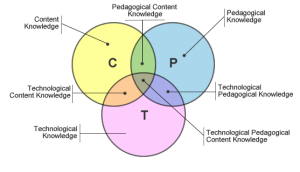Synthesis of Interviews:
After reading all of the interviews posted thus far and engaging in several discussion threads I started to think about what do we do with all this information? It is remarkable to me that several of the barriers to using technology in the classroom resonate through many of the posts. Our interviewees were of varied ages, genders, experience level and current job placements, yet the underlying issues remained constant.
Rather than dwell on the things we can all plainly see are barriers I wanted to start a discussion on how we can improve some of the problems we encounter. I realize I may be naïve in thinking that if we can decide on some improvements we clearly see as necessary we can start things moving in the right direction.
These are the things that I took away from our interview posts:
1) We need better in servicing and training of staff at every level in order to have teachers feel comfortable using technology WITH their students. (As Dana stated it would be nice if we could just call the Prime Minister’s office and say, “hey we are teachers across Canada, we have a Wi-Fi issue that needs to be addressed or we can’t use this technology in our schools”. Unfortunately, education in Canada is governed at the provincial level and sadly I doubt Wi-Fi is an issue they will all get on board with. I also think Stephanie’s Mentorship plan (including mentoring technology) is a super awesome idea and I hope it catches on with every school district. The mentors in our schools never deal with technology other than here is how the report card works.
2) We need teachers to value technology, not as a tool to do what has always been done but to do things differently and engage students. As I mentioned in a previous post there is medical evidence emerging that clearly demonstrates children’s (digital natives) brains are wired differently than previous generations. (Levitan, 2014) if we do not change how we try to teach these students, I fear they will become a lost generation, stuck between old teaching methods and a new career world. I recently read a book by Ross Greene (2014) called Lost at School (Why our Kids with Behavioural Challenges Are Falling Through the Cracks and How We Can Help them). What I kept thinking about as I read this book was that yes we definitely have students with severe behavioural issues in our schools, but is that number rising because of what many on my staff would like to call poor parenting, environmental issues? Or is the number seemingly rising because we are failing to engage them on the level they require?
3) It is time to blend our teaching with Problem Based Learning (PBL), Genius Hour or 20% Time and allowing our students to direct much of their own learning, in essence allowing them to choose the differentiation that works for them. We need our students interacting with their learning. Trying, failing, trying again and understanding what perseverance is. If you want to learn more about these processes I have three recommended reads: Learning by Choice (by A. J. Juliani, 2014), Pure Genius: Building a Culture of Innovation and Taking 20% Time to the Next Level (by D. Wettrick, 2014) and inquiry and Innovation in the Classroom: Using 20% Time, Genius Hour and PBL to Drive Student Success (by A.J. Juliani, 2015). These three, easy reads helped demystify the PBL process for me.
When I consider the TPCK framework as described by Mishra and Koehler (2006) and apply my understanding of both TPCK (see basic TPCK visual below) and PBL’s I see the perfect merging of theories.

The use of PBL’s in Science and Math provide the perfect opportunity for educators and students to hit the sweet spot of the TPCK Venn diagram incorporating all facets of Content, Technological and Pedagogical Knowledge.
4) We need to recognize, as mentioned in one of the posts, that we are attempting to prepare students for a future none of us understands. How can we do this? The answer to me is that the material we use today is only a vehicle that we use to help our students learn to become innovators, problem solvers and critical thinkers. Already most employers are looking for employees who have these skills over those who just achieved high grades in an outdated education system. My final recommended read is Creating Innovators: The Making of Young People Who Will Change the World by T. Wagner (2012). Although I am only half way through this book but I am already thinking differently.
References:
Greene, R. W. (2014). Lost at school: why our kids with behavioral challenges are falling
through the cracks and how we can help them. New York: Scribner.
Juliani, A. J. (2014). Learning by choice: 10 ways choice and differentiation create an
engaged learning experience for every student. Ambler, PA: Press Learn.
Juliani, A. J. (2015). Inquiry and innovation in the classroom: using 20% time, genius hour,
and PBL to drive student success. New York: Routledge.
Levitin, D. J. (2014). The organized mind: thinking straight in the age of information
overload. New York, NY: Dutton.
Mishra, P., & Koehler, M. (2006). Technological pedagogical content knowledge: A framework
for teacher knowledge. The Teachers College Record, 108(6), 1017-1054.
Wagner, T., & Compton, R. A. (2012). Creating innovators: the making of young people who
will change the world. New York: Scribner.
Wettrick, D. (2014). Pure genius: building a culture of innovation and taking 20% time to
the next level. San Diego, CA: Dave Burgess Consulting, Inc.
Thank you Catherine for this and for taking the initiative!
Samia